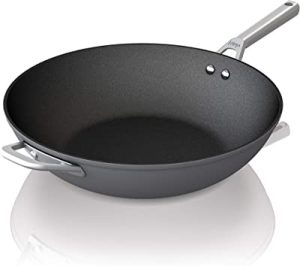Some people might dispute my belief that a cast iron skillet is the most useful, versatile piece of cookware you can own. I understand. I suppose a lot depends on your cultural heritage. If you grew up in a yurt on the Mongolian plains or in a hutch among the rice patties of rural China you would disagree. You would say that the wok, that ubiquitous Chinese cooking vessel, was more versatile and useful. But that’s probably just because you didn’t grow up cooking on a modern American cooktop.
And that’s the real problem with the wok in American home kitchens. Woks, made of carbon steel, like swords, are great on an open flame. The small, hot fires of rural Asia were what the wok was designed for. And it does that great. Controlling heat on such a fire isn’t easy, and the wok gives the cook varying temperature surfaces so food doesn’t overcook or come out underdone.
Also, the wok is great for camping or other open fire cooking. It can be used to make soup, heat water for washing and be used as a temporary holding spot for odds and ends.
But American cooktops are flat. Even with one of those rings, the heat is very uneven and doesn’t get near hot enough. Also, the heat that leaks out of the ring can cause the stovetop finish to be burned or blackened. So, a wok just doesn’t work that well there.

Instead, use a wok pan. What’s the difference? A traditional wok is heavy and usually has two handles, like a pot. It is shaped like a shallow bowl. But a wok pan has a flat bottom, allowing the cooking surface to be heated evenly on the flat cooktop. And instead of two small handles on the sides, the wok pan has a long handle like a saucepan. That makes it much easier to handle on a typical stove top. Some of the larger models have a small handle on opposite side making it easier to handle the weight.
Wok pans also are made of high-grade aluminum, keeping the weight down but the heating ability high. The shape of the sides still gives you the same stir-frying and cooking ability of a traditional wok. Many are non-stick but without the usual coating. Instead, these pans use a texture inside the pan to keep food from sticking. It’s not fool-proof, but for most stir-frying, it works well. A regular non-stick coating would break down under the high heat usually used in stir-frying. This hybrid pan is really a good choice and I use mine all the time.






